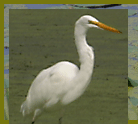Curriculum Ideas
This web site isn't a lesson on wetlands, it is a tool or reference that can be a part of a larger lesson on wetlands, ecosystems, etc.

The website offers video of wetlands animals that can be a starting point for discussions about wetlands, ecosystems, or related topics. The online 3D diorama allows students a chance to interact with wetlands animals.
The website relates to the NSTA content standards for levels 5-8 in several ways.
Systems, order, and organization:
The are several systems operating in the wetlands. The system that is most apparent in the video is the food web. Students could use what they see in the videos (along with their prior knowledge and information gathered from other sources) to construct a food web.
Form and function:
After constructing a food web, students could use that web to describe how each animal is adapted to its ecosystem. Discussion might touch on adaptations such as coloration, movement, dexterity, weapons (claws, beaks, etc.).
Questioning:
In addition to the content standards, this website could be used to further other goals in the standards. For instance, students should be encouraged to generate questions that will guide their learning about wetlands, and then to revise those questions as they get more information and insight. Beginning questions might be along the lines of:
What is a wetland?
What are wetlands good for?
What animals live in wetlands?
What do the animals eat?
More refined questions might be:
What are some of the characteristics of a wetland?
What purposes do wetlands serve for animals and for humans?
What animals, birds, fish, bugs, and plants are found in wetlands? How do they interact?
What do the animals eat, and what eats them? How does energy move through the system?
Illustrations:
The standards encourage students to make charts, graphs, and illustrations related to their learning. Students can arrange the diorama to make illustrations for use in reports or presentations. There is a button that allows a scene to be copied to the clipboard. That image can be pasted into many word processors or software for presentations.
Evidence:
Students might be encouraged to think about the videos as evidence to support theories about animals and their interactions with their ecosystem. To what extent are the videos "good" evidence and to what extent are they "skewed?"
Other Topics:
- Can students extend the evidence in the video through their own experience with other ecosystems (or with information gained from other sources)?
- What animals are competing for resources?
- How do humans fit into a wetland ecosystem (beyond fishing)? In what ways are humans competing for resources?
- For each animal observed, how many ways can students list that the animal is well adapted to its environment?
- Can students identify how energy enters the food web and is moved through the system; producers, consumers, decomposers?
|






